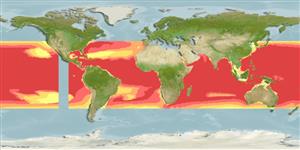Common names from other countries
Environment: milieu / climate zone / Tiefenbereich / distribution range
Ökologie
seewasser bathypelagisch; tiefenbereich 50 - 1352 m (Ref. 74511). Deep-water; 41°N - 40°S, 98°W - 110°W
Worldwide. Eastern Atlantic: Madeira (Ref. 4769), Canary Islands (Ref. 6808) and Cape Verde (Ref. 27000); Senegal to Gulf of Guinea (Ref. 4463). Western Atlantic and Indo-Pacific: in tropical and subtropical waters (Ref. 4463), including the Gulf of Mexico (Ref. 27768). Eastern Pacific: California Current region (Ref. 35800). South China Sea (Ref.74511).
Size / Gewicht / Alter
Geschlechtsreife: Lm ? range ? - ? cm
Max length : 6.6 cm SL Männchen/unbestimmt; (Ref. 4463)
Rückenflossenstacheln (insgesamt) : 0; Rückenflossenweichstrahlen (insgesamt) : 16 - 18; Afterflossenstacheln: 0; Afterflossenweichstrahlen: 26 - 31. Dark dorsally, silvery finish on translucent flanks; fin rays colorless; black pigment at base of each dorsal and anal ray (Ref. 3991). Branchiostegal rays: 11-12 (Ref. 35800). Longer trunk and shorter tail (Ref. 37473).
Body shape (shape guide): elongated.
Mesopelagic (Ref. 58302). Exhibit diel vertical migrations, juveniles and adults mainly at 300-600 by day and at 50-200 by night (Ref. 4463, 58302). Feed on copepods and euphausiids (Ref. 4769). Photophores developing in fishes over 12-20 mm SL (Ref. 4769). Oviparous, with planktonic eggs and larvae (Ref. 35800).
Life cycle and mating behavior
Geschlechtsreife | Fortpflanzung | Ablaichen | Eier | Fecundity | Larven
Quéro, J.-C., J.C. Njock and M.M. de la Hoz, 1990. Gonostomatidae. p. 283-292. In J.C. Quero, J.C. Hureau, C. Karrer, A. Post and L. Saldanha (eds.) Check-list of the fishes of the eastern tropical Atlantic (CLOFETA). JNICT, Lisbon; SEI, Paris; and UNESCO, Paris. Vol. 1. (Ref. 4463)
IUCN Rote Liste Status (Ref. 130435: Version 2025-1)
Bedrohung für Menschen
Harmless
Nutzung durch Menschen
Fischereien: nicht kommerziell
Tools
Zusatzinformationen
Download XML
Internet Quellen
Estimates based on models
Preferred temperature (Ref.
123201): 7.6 - 17.3, mean 11.1 °C (based on 943 cells).
Phylogenetic diversity index (Ref.
82804): PD
50 = 0.7500 [Uniqueness, from 0.5 = low to 2.0 = high].
Bayesian length-weight: a=0.00389 (0.00172 - 0.00881), b=2.99 (2.79 - 3.19), in cm total length, based on LWR estimates for this (Sub)family-body shape (Ref.
93245).
Trophic level (Ref.
69278): 3.0 ±0.13 se; based on food items.
Widerstandsfähigkeit (Ref.
120179): hoch, Verdopplung der Population dauert weniger als 15 Monate. (Preliminary K or Fecundity.).
Fishing Vulnerability (Ref.
59153): Low vulnerability (10 of 100).
🛈
